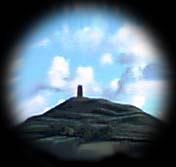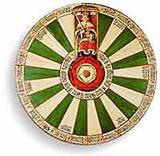Explorations in Arthurian History
The Places
|

|
- Agned: the
site of the 11th of the 12 great battles of Arthur
according to Nennius. Some manuscripts give the name as
Breguoin. Click here
for more about the battle.
- Annwn: land
of the underworld, a magical
world across the water, take
your pick. Spoils
of Annwn mentions Arthur
by name.
- Avalon: the
sacred island Arthur is said to have been taken to after
receiving his mortal wound. It has never been positively
placed in the geography, but the good folks in
Glastonbury would have you believe that Glastonbury Tor,
which was an island centuries ago, was Avalon. For more,
click here.
- Badbury
Rings: Iron Age hill-fort that is a contender for the
site of the Battle of Badon Hill. An aerial
view highlights its high
ground, fortification ditches, and junction of several
Roman roads.
- Badon
Hill: the site of Arthur's greatest victory over the
Saxons. It is the last of Arthur's 12 victories, but its
exact location has not been determined. Geoffrey locates
it at Bath, but all that is really known is that it was
somewhere in southern Britain. The sources
and arguments
are many. Click here
and here
for other views and here
for a discussion of the politics of the time.
- Bassas:
site of the sixth of the 12 great battles of Arthur
according to Nennius. Click here
for more about the battle.
- Bath: major
Roman site and home to hot springs. Many
structures of Roman times
still stand. Geoffrey says Bath was Badon Hill. Indeed,
the British pronunciation of Badon could very well have
been Bath-on.
- Brittany:
French territory that is home to many Arthurian legends.
The Broceliande forest is in Brittany. Click
here
and especially here
for a brief history of Brittany and here
for a list of kings.
- Broceliande:
the mystical
forest is mentioned in many of
the tales, including those by Wace and Chretien. It is
also the place, tradition holds, where Niniane held
Merlin captive. In the heart of Britanny, which has its
own distinct Arthurian tradition.
|
|

|
- Cadbury
Castle: a castle in Romano-British times. Serious
excavations at this site lend evidence to modern
historian/archaeologist Leslie Alcock to conclude that
this might indeed have been Camelot. For more, click
here
and especially here.
and here
- Caerleon:
site of Arthur's plenary court and Guinevere's convent,
according to Geoffrey of Monmouth. Also, an amphitheater
uncovered here is in the shape of a large round mound,
giving rise to the legend that this was the true Round
Table. Further, some think that Caerleon was Nennius's
City of the Legion. For more, click
here
and here.
- Caledonian
Forest: site of the seventh of the 12 great battles
of Arthur, according to Nennius, who lists it as Celidon.
Click here
for more about the battle. This forest is also said to be
the place where a mad Merlin took refuge.
- Camelot:
the legendary court and capital of Arthur, it has not
been positively placed in the geography, though modern
historian/archaeologist Leslie Alcock makes a good case
for Cadbury. For more about the legend, click
here
and here.
- Camlann:
site of the final battle of Arthur. As with Badon Hill,
the location has yet to be conclusively proven. Some
contenders: here,
here
and here.
- Carmarthen:
birthplace of Merlin according to Geoffrey. Name means
"Myrrdin's Town" in Welsh. Present-day Carmarthen has
many sites with Merlin's name, including Bryn
Myrrdin, Merlin's Wood and
Merlin's Stone. Site of the Black Book of
Carmarthen, which contains an oblique reference to
Arthur in the tale of the Battle
of Llongborth.
- Castle
Dore: Cornwall castle thought to be tied the story of
Tristan and Isolde.
- Catterick:
site of battle that is the subject of the
Gododdin.
- Certicesford:
"Cerdic's ford," battle fought between Britons and
Saxons about 520 in southern England. Some think that
this was the Battle of Camlann, Arthur's last
battle. The Anglo-Saxon Chronicle says it was a Saxon
victory after the Britons had demolished
themselves.
- Chester:
originally the Roman fortress of Deva, founded to control
the Brigantes and Ordovices. Click here
for more information.
- City
of the Legion: site of the ninth of the 12 great
battles of Arthur, according to Nennius. Click
here
and especially here
for more about the battle. Some say it was Chester;
others say it was Caerleon. Nennius called it "Cair
Lion."
- Colchester:
Britain's oldest town and first Roman capital.
Some
scholars think that Colchester
was Camelot. Indeed, the Roman name was Camulodnum.
Later became part of the Saxon kingdom of East
Anglia.
- Cornwall:
many of the great Arthurian legends come from Cornwall
and are associated with places there.
Cunomorus, a leader in the 6th century, is thought to be
the basis for both King Mark and Mordred. With Mark comes
the story of Tristan and Isolde. Merlin is also said to
be involved in many legends of Cornwall. Click
here
for a general history of the region.
|
|

|
- Devon: with
Cornwall made up the powerful kingdom of Dumnonia.
- Dinas
Emrys: Iron Age hill-fort in Gwynedd thought by some
to be alternately Ambrosius's or Vortigern's
hideout. Also thought to be the hill wherein Merlin made
his name famous by seeing the Red and White Dragons.
Click here
for more. Click here
for extensive inquiry.
- Dumnonia:
powerful
kingdom containing both Devon
and Cornwall in ancient Britain. Click here
for a list of the kings of Dumnonia and here
for more information.
- Dubglas:
river in the Linnuis region listed as the sites of
the second through the fifth of the 12 great battles of
Arthur by Nennius. Click here
for more about the battles.
- Dyfed:
powerful
kingdom of ancient Britain.
According to Geoffrey, Merlin's mother was Princess of
Demetia, which is Dyfed. Click here
for a list of the kings of Dyfed. Dyfed is also the home
of Pwyll, who met a prince of Annwn in the first branch
of the Mabinogion.
- Ercing:
lesser
kingdom of ancient Britain and
site of tomb thought to belong to Amr, the son of Arthur.
(See Nennius.)
- Glastonbury:
The good folks at Glastonbury claim that Arthur's (and
Guinevere's) remains were found here in the 12th century.
That claim notwithstanding, Glastonbury was the site of
the first permanent British Christian community. Legend
has it that the famous abbey was the inspiration of the
community's first great leader, Joseph of Arimathea, not
coincidentally the legendary bearer of the Holy Grail to
Britain. For more, click here
and here.
- Glein: or
Glen, river that was the site of the first of the 12
great battles of Arthur according to Nennius. Click
here
for more about the battle.
- Gododdin:
ancient
kingdom between Hadrian's Wall
and the Antonine Wall. People forced to move to Wales, a
migration recorded in the ancient Welsh work the
Gododdin. Click here
for a list of the kings of Gododdin.
- Guinnion:
site of the eighth of the 12 great battles of Arthur
according to Nennius. Click here
and here
for more about the battle.
- Gwent: also
known as Ewyas.
Ancient
kingdom of Britain. Click
here
for a list of the kings of Gwent.
- Gwynedd:
powerful
kingdom of ancient Britain
(repopulated by the migration from Gododdin) said to be
ruled jointly by the king of Powys in Arthur's time.
Click here
for a list of the kings of Gwynedd.
|
|

|
- Kent:
Saxon
stronghold founded by Hengist
and held by his son Octha.
- Liddington
Castle: prominent Iron Age hill-fort near Badbury.
Thought to be contender for the site of the battle of the
Badon Hill. Click here
for a view of archaeological excavations.
- Lincolnshire:
Anglian area containing the River Glen and Lindsey,
thought to be the sites of Arthur's second through sixth
battles.
- Lindsey:
thought to be Linnuis, site of four of the 12 great
battles of Arthur according to Nennius.
- Linnuis:
region containing the river Dubglas, site of the sites of
the second through the fifth of the 12 great battles of
Arthur by Nennius. Click here
for more about the battle.
- Little
Solsbury Hill: high hill overlooking Bath. Some say
it was the site of the Battle of Badon Hill. For a view
from the top, click here.
- Llongborth:
battle in which Arthur was directly or indirectly
involved. So say the Black Book of Carmarthen and
the Book of Taliesin. Click here
and here
for more.
- Logres:
alternately a kingdom or the whole of England. Geoffrey
names it the latter. It is also the setting of Chretien
de Troyes's Chevalier de la charrette and
Perceval. Click here
and here
for more.
- Lothian:
land in Scotland. King was Lot, alternately supporter or
foe of Arthur, depending on the source.
- Lyonesse:
the lost
kingdom, said to be across the
water. Often associated with Cornwall.
Click here
for more.
- Mercia:
Saxon kingdom founded by leader Offa.
The success of Offa sounded the death knell for British
influence outside Wales. Click here
for a map of Mercian conquests and here
for a list of the kings of Mercia.
|
|

|
- Powys:
powerful
kingdom of ancient Britain.
Click here
for a list of the kings of Powys.
- Stonehenge:
the Giants' Dance (or Ring in Geoffrey), the circle of
stones thought to be the burial place of many great
British heroes, among them Uther Pendragon. For more,
click here
and here
and here.
- Sussex:
Saxon
stronghold founded by leader
Aelle, the first Bretwalda.
- Thanet:
island occupied by Saxon leaders Hengist and Horsa as
compensation from Vortigern for helping him fight
encroaching Picts. Click here
for a lesson in the history of Thanet.
- Tintagel:
the legendary birthplace of Arthur, according to Geoffrey
and subsequent romancers. In the Tristan stories,
Tintagel Castle belongs to King Mark. For more, click
here
and here
and especially here.
- Tribruit:
site of the 10th of the 12 great battles of Arthur,
according to Nennius. Click here
and here
for more about the battle.
- Viroconium:
ancient Roman
military stronghold in western
Britain. Capital of the Cornovii tribe and seat of power
of Vortigern in Powys. See also
Wroxeter.
- Wessex:
Saxon
stronghold founded by Cerdic.
Click here
for more information.
- Wroxeter:
city built in and around the Roman city of Viroconium.
Modern archaeological inquiries include a
major
excavation and a
virtual
tour.
|
Back to

Explorations in Arthurian History and
Legends
Main
Page
Other







